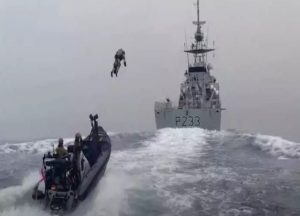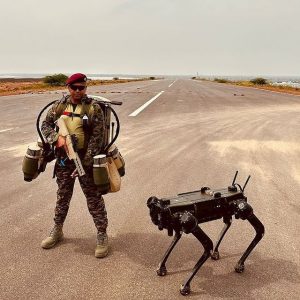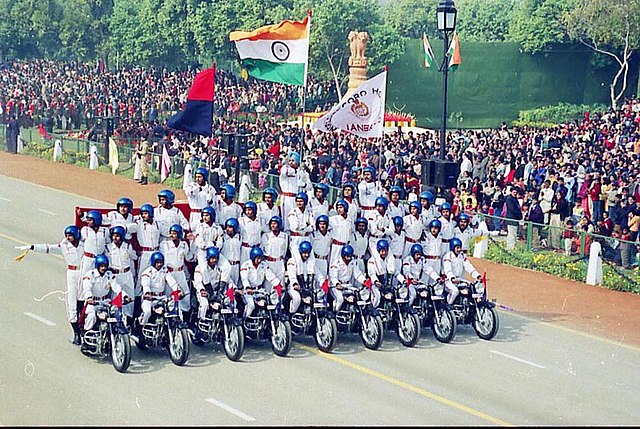
Jet Pack Suits: Indian Army Soldier Goes Hi-Tech

The futuristic Indian Infantry soldiers wearing Jet-Suits could soon be seen patrolling along the borders with China and Pakistan. The Special Forces troopers with strapped-on gas turbine jet packs would soon be zooming at more than 50 mph toward the target in the not-so-distant future. In short, the foot soldier would now be manoeuvring in the aerospace in his operational area of interest. The new form of military aviation has arrived, throwing an infantryman’s time and space dilemma into the winds.
So what is this new technology that is likely to be in the hands of an infantry man?
A Jet-Suit is an individual strap-on jet propulsion technology that allows a person to fly using small, powerful jet engines attached to their body. The suit typically consists of several small jet engines attached to the arms and back of a specially designed suit or harness, which allows the wearer to control their movements and direction of flight.
These Jet-Suits aren’t new; however, their military application is new and evolving. Jet-Suits first came into existence in the 60s as technology demonstrators. They have so far been typically used by individuals such as stunt performers in movies, extreme sports enthusiasts, and emergency responders in situations where quick and agile movement is necessary. Now the militaries are exploring the usage as the technology gets advanced and user-friendly.
The military version Jet-Suit was developed by a UK-based company, the Gravity Industries. It was the owner Richard Browning who invented his Daedalus Flight Pack back in 2016 which enabled a person wearing it to hover and fly. Gravity Industries, manufacturer of the Jet Suit, were the first to demonstrate their high-flying personal jet pack technology in military use during a NATO mountain warfare rescue exercise held in Slovenia in December 2021.
According to the company, the Jet-Suit is powered by five gas turbine engines that generate more than 1,000 horsepower and produce 144 kg of thrust that allows vertical lift of up to 12,000 feet. The personal propulsion system moves at speeds of more than 50 mph and has a typical flight time of up to four minutes. It runs on jet fuel, diesel, or kerosene. Gravity Industries’ says this technology is prime for search and rescue and medical rescue operations. Ever since 2021, the military imagination of employment of Jet-suits has moved beyond logistic application, into the realms of specialised military operations.
Militaries across the world are looking at this technology as a force multiplier in domains from marine warfare to mountain warfare to countering terrorist threats in urban and semi-urban settings to various specialised manoeuvres in conventional operations. In India too, this technology has caught the imagination of military strategists. Apart from the influx of drone technology on the battlefield, Jet Packing could well prove to be another major disruptor in the tactical battle space.
RFP for Jet Suits. The Ministry of Defence (MoD) has issued a Request For Proposal (RFP) for 48 Jet Pack suits. The RFP is being made as an emergency procurement through the Fast Track Procedure (FTP) under the Buy Indian Category. The indigenous content requirement is greater or equal to 60% as per DAP 2020 and 50% if it is indigenous design. As per the Request for Proposal issued by the Ministry of Defence, the technical parameters should include a total system weight of less than 40 Kg. It should have any Modern Propulsion System including Turbine engines/ Electric and Hybrid Systems. The max speed should not be less than 50 Km/h. The payload carrying capacity should not be less than 80 Kg. The Jet Pack should afford the soldier wearing it a minimum flying time of 8 minutes and should be capable of being deployed at operating altitudes up to 3000m. The equipment should be capable to operate satisfactorily in plains, mountains, deserts & high-altitude areas.
Going by the media reports, a Bengaluru-based company is in the race to supply jetpacks for the armed forces of India. The Indian Army is looking at jetpack suits, which will enable its personnel to fly to enhance individual mobility in tough terrain. As per India’s leading daily, The Hindu, “the jet suit developed by Absolute Composites in Bengaluru will be among those that will be evaluated by the Indian Army for procurement. At present, Absolute Composites is the only Indian company to make the jetpack suit”.
As of now the jetpack developed in Bengaluru by Absolute Composites appears to be fitting in the requirements projected by the MoD. Their system is reported to have a range of 10 km and is capable of flying for up to 8 minutes. The pack weighs 40 kg and can carry a payload of 80 kg. Though it is capable of taking off at an altitude of 3,000 meters, the optimal height after deployment is between 10 feet and 20 feet above the ground.
Likely Employment Scenarios
Since this equipment is new in the domain it will undergo extensive evaluation and validation before it finds a place in our tactical doctrines. Employment of this specialised equipment would vary from terrain to terrain. There is going to be a logistical application of the Jet-Suits, however they would eventually find employment in special operations which would aim at overcoming terrain friction, disrupting the enemy in time and space either at sea or on land.
With the Navy’s MARCOS, Jet-Suits would come handy in carrying out anti-piracy operations, swiftly getting on board the seized merchant ship and freeing the hostages to carrying out searches of suspected vessel on the high seas. In our Indian Ocean Region, jet pack marine commandos could effectively carry out tasks like reconnaissance and patrolling the littorals, creeks and remote coastal areas far more effectively and efficiently.

Source: Screenshot of Gravity Industries video
With the land forces, these could well mean swift surveillance and dominance of remote passes in our mountainous regions. Mission based patrolling could well be a task cut out along the LAC and the LC in Himalayas. During conventional operations, special forces could be employed with jet packs in securing intermediate obstacles or defiles and passes in enemy’s rear before a link up. During the water obstacle crossing, securing a crossing and ferry point for the advancing columns could well mean saving crucial hours. And like wise moving immediate replenishment store after the capture of an objective in the reorganisation phase will make a huge difference in victory and a defeat. There could be more different and imaginative ways that this equipment be employed in No-War-No-Peace or Hot-War scenarios in days ahead.
This equipment could be of high value in dealing with a Mumbai like terrorist strike of 26/11. Scaling of high rise building in quick time for top down clearance, the jet-packs could be force multipliers. These have vast scope of usage in counter terror operations in Kashmir hinterland and in Naxal operations in central India. This equipment will prove itself as a lifesaving tool for sick and wounded soldiers in remote and weather cut off posts. Flying medicos could well be a reality along the Chinese and the Pakistani border with the troops deployed along the LAC and the LC.
These can also be of immense value in carrying out search and rescue missions in densely forested areas in the country. Just to recall, last year an army helicopter carrying five people crashed in Arunachal Pradesh’s Upper Siang district on October 21, 2022. Hilly terrain with thick forest cover, the site of the crash was not connected by any road. The weapon system integrated version of an Advanced Light Helicopter (ALH) crashed near Migging village. Three aerial rescue teams were sent to the location, only two could reach the site after six hours of crash. Under such circumstances Jet-Suit rescuers could be have been of a immense help. May be some lives could have been saved.

Source: Social Media
As the technology advances new innovative ways for employment would be explored. The day is not far when jet-packs will percolate down to regular infantry, artillery and armour units. Wherein troops would be carrying out route recces, fire control and communication tasks apart from other offensive manoeuvres at tactical and sub tactical levels. In addition to the military usage, Jet-Suits could find their employment an effective quick response Border policing along the fence with Pakistan, Bangladesh and Myanmar in countering infiltration, drug and gun smuggling operations.
Limitations
Notwithstanding the above stated likely employment scenarios, these jet packs do have serious limitations. High decibel jet noise will take away the flexibility for any stealth usage, a primary factor in any consideration for special operations behind the enemy lines. Apart from this, low endurance and high maintenance could vastly impact employment of Jet-Suits at a large scale. In addition to this, the man made obstacles in form of power lines and antennas could also pose a threat to in-flight safety of these troopers.
Conclusion
While the Jet-Suit technology shows significant promise for defence applications, there are, however, a number of complications that need to be overcome before this technology is ready for operational deployment. Easy targeting is one such major challenge – the jetpack troopers would be highly vulnerable as a target in its present form, this risk increases manifolds due to flammable jet fuel onboard. Restrictions on all up weight will have a toll on soldier’s body armour and weaponry that he could carry. Dwelling upon various aspects of this new form of military aviation, it needs to be seen whether the Jet-Suit soldier will end up as a fantasy or a highly potent force multiplier on the futuristic battlefield.
Disclaimer
The opinions expressed in this article are the author’s own and do not reflect the views of Chanakya Forum. All information provided in this article including timeliness, completeness, accuracy, suitability or validity of information referenced therein, is the sole responsibility of the author. www.chanakyaforum.com does not assume any responsibility for the same.
Chanakya Forum is now on . Click here to join our channel (@ChanakyaForum) and stay updated with the latest headlines and articles.
Important
We work round the clock to bring you the finest articles and updates from around the world. There is a team that works tirelessly to ensure that you have a seamless reading experience. But all this costs money. Please support us so that we keep doing what we do best. Happy Reading
Support Us















POST COMMENTS (0)